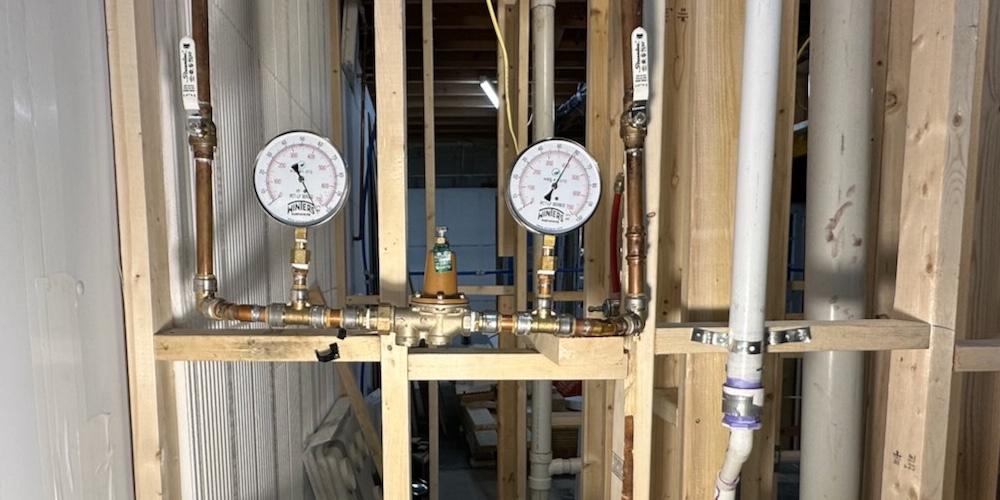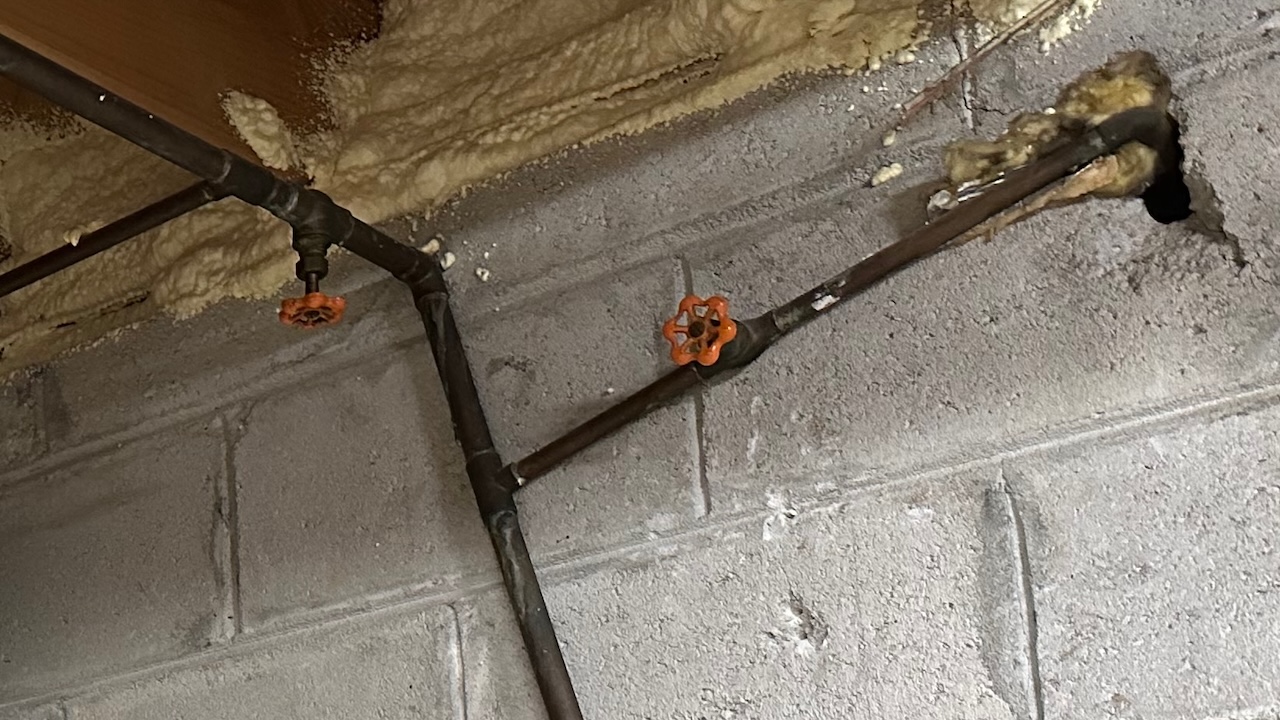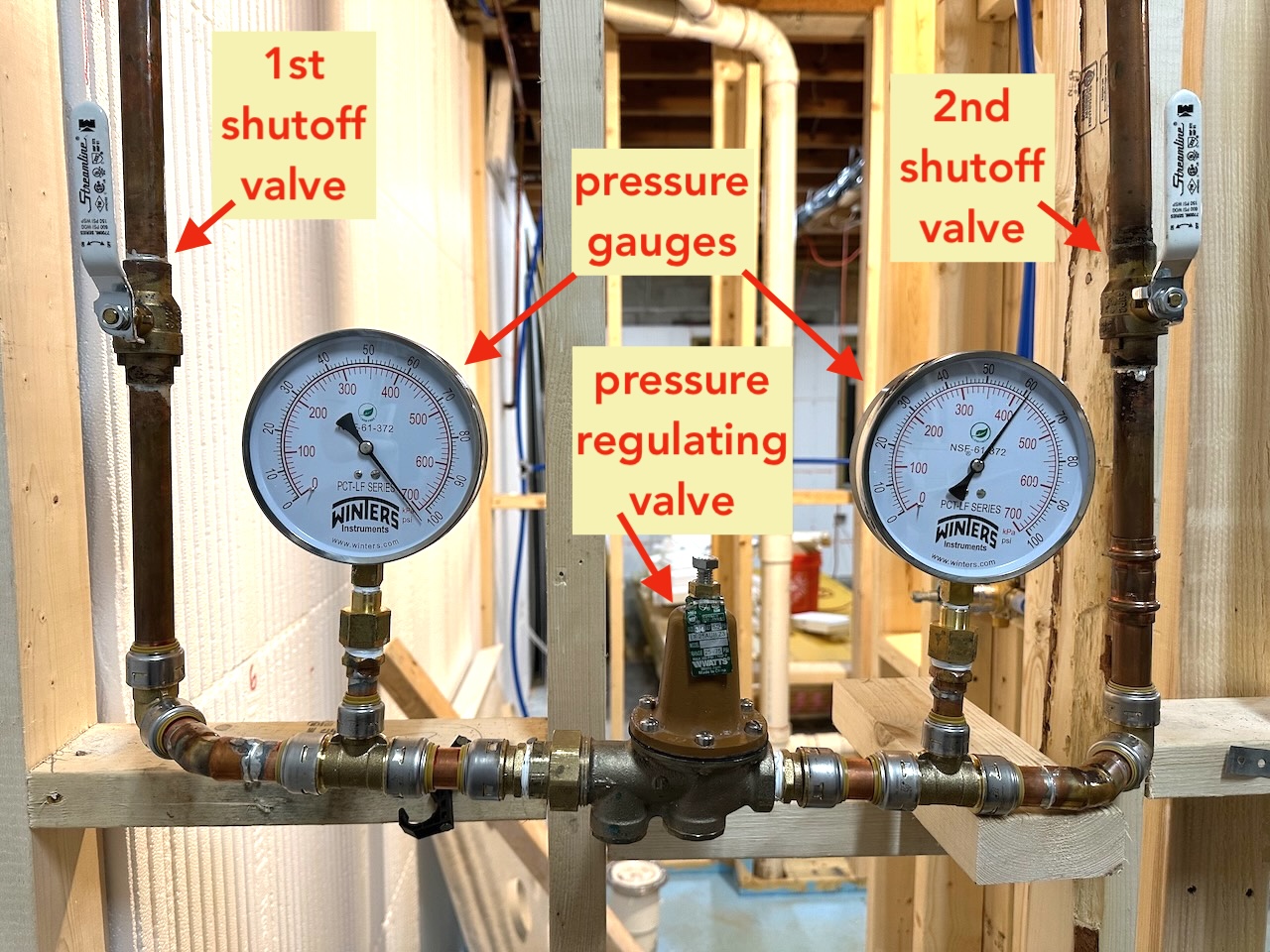A Plumbing Feature Every Home Should Have

As we know from the most recent natural disaster to hit the US (Hurricane Helene), it’s good to do some emergency planning before an emergency strikes. But let’s take a more common example: plumbing leaks in your home. If it happens, can you quickly and easily turn off the water? For many people, the answer is probably no. If you’re in that group, read on. Or skip to the bottom and watch the video.
An indoor shutoff valve upgrade
I’m in the process of remodeling my basement, and we’re taking the opportunity to upgrade our plumbing system at the same time. One of the things I did is change how the water comes into the house. As you can see below, the supply pipe that came into the basement did indeed have a shutoff valve. But guess what. That valve was buried behind a closet with only a small access panel. (The valve to shut off water to the house is the one on the left. The pipe on the right goes to an outdoor hose bib.)

It’s also a gate valve. That type of valve is notorious for corroding and leaking. And yes, both of these did. I messed with them a couple of times before I realized it was best not to touch them. So that meant having to go out to the street and turn off the water at the meter. For a couple of years now, I’ve been planning to move the valve to the mechanical room, where it would be more accessible. I also knew I wanted a ball valve for my shutoff instead of a gate valve.
Some other features of my inlet water supply
The lead photo above shows my new configuration, and there’s an annotated version of it below. The inlet water pipe goes below the ceiling joists and into the mechanical room. There it drops down to a convenient height. The first thing the water hits is the main shutoff valve. Then it comes to a gauge that measures the incoming water pressure. As you can see, ours is more than 100 pounds per square inch (psi), which is very high.

So the next component the water reaches is a pressure regulating valve. We don’t want to send 100 psi pressure throughout the house because that can be bad for plumbing fixtures. The regulator allows us to bring it down to a more reasonable 60 psi. And we know that because of the second pressure gauge just past the pressure regulator. Then there’s a second ball valve in case we have to replace the pressure regulator or a leaky fitting. (People keep telling me those SharkBite fittings leak, so I’ll keep an eye on them.)
Good design for shutoff valves
In short, to minimize damage from plumbing leaks, put a shutoff valve in a convenient place. Don’t put it on the far side of the crawl space or just under the basement ceiling joists. Put it where someone can easily walk right up to it and turn it off. No crawling. No ladders. No guessing the location.
Then use a good quality valve, preferably a ball valve. They close more quickly than gate valves and generally last longer.
For more on this subject, watch our new video below. (And please hit the like button and subscribe to our YouTube channel!)
A further step you can take is to install a smart valve. The two I’ve heard the most about are the Phyn and the Moen Flo, but there are others as well. I’m probably going to put one of those in later. (This basement remodel is already costing a lot!) If you have experience with any of these devices, please share it with us in the comments below.
Allison A. Bailes III, PhD is a speaker, writer, building science consultant, and the founder of Energy Vanguard in Decatur, Georgia. He has a doctorate in physics and is the author of a bestselling book on building science. He also writes the Energy Vanguard Blog. For more updates, you can follow Allison on LinkedIn and subscribe to Energy Vanguard’s weekly newsletter and YouTube channel.
Related Articles
Faster Hot Water Can Change Your Life
Efficient Hot Water Delivery With a Simple Tool
Comments are welcome and moderated. Your comment will appear below after approval.

Be careful when putting two shutoff valves in series on a liquid line without a pressure relief valve in between. If you shut off both valves with relatively cool water in between, and that water warms up, you can get quite a bit of hydraulic expansion and possibly enough pressure rise to break something.
Roy: Thanks for the warning. This is still a work in progress, so I’ll look into adding a pressure relief valve. I can’t imagine a situation where I’d close both valves and leave water in the closed-off section for more than a few minutes, but it’s better to be safe than sorry.
I am not sure if I would put in a pressure relief valve. I was just warning you and others to avoid shutting off the same liquid line in two places for a very long period of time. As for expansion tanks, I don’t think they are required unless you have a “closed” system which is usually when the water utility requires a backflow prevention device (check valve). But if you don’t have an expansion tank, and you shut off your main supply valve for a long period of time (e.g., vacation), you should open a faucet or two to prevent hydraulic expansion.
make sure to add an expansion tank ( sized to your water heater) as pressure can build up on home side of the pressure regulator .
Robert: Good advice. I don’t remember if the house had one when we bought it in 2019, but we had one put on our new heat pump water heater in a few months after we moved in.
Great suggestion. Something I learned the hard way is to identify all shut-offs before you start work on any home (I knicked a water pipe with a Sawzall). As a standard practice, we made all our crews find the electrical main/service panel, the gas meter with shut-off, and the water supply shut-off before they started any work on a home. Lots of houses have irrigation valves that look like water supplies, so it is not always easy. One thing you need to be aware of with your water supply set up is you will need an expansion tank on your cold supply to your water heater, as you now have a closed system. (a good thing to add regardless) Good info as always – Allison keep up the good work.
Charley: I also knicked one of my supply pipes with a reciprocating saw and had to do some unplanned plumbing work. I was surprised how quickly that blade can go through a copper pipe…and I wasn’t using the metal blade. And yep, we added an expansion tank when we replaced the gas water heater with a heat pump water heater in 2019.
In every house I build, I have the plumber run the main water line into a wall in the laundry room, with a plastic access wall box prominently placed above waist height . I have them install a ball valve, with the handle positioned so that all one has to do to shut off the water is open the panel door, pull the handle outward to shut off the water. The door now not shut with the handle pointing outward, letting everyone know the water is off. No questions about which way to turn it. There are no questions about where the shutoff is while water is spraying all over the place.
Tom: I love that! You’ve really thought this out and the folks who buy your homes benefit from that careful thinking.
If my HVAC teams encounter CPVC plumbing lines in attics anywhere near where they work or transit work does not begin until water is verified off. Elderly CPVC lines are notorious for becoming brittle over time in attics, and it simply isn’t worth the cost / risk of a minor misstep.
There inevitably follows a conversation in which it is revealed that 9 out of 10 homeowners haven’t the foggiest notion how to turn off their water service at all, never mind quickly.
A friend of mine, an otherwise well-squared away retired MD, recently incurred 5 figure damage to his home owing to pipe damage in the course of remodeling…it was a L-O-N-G time before water was able to be shut off, turning what could have been a minor mess into a major loss that took months to resolve and repair.
I put a 90-day recurring reminder in my phone calendar to exercise the valves in my house, including sink and toilet shutoffs. Just a quick on/off cycle on each valve keeps it moving freely if/when an emergency arises. You can also add “dust your ceiling fans” to the same reminder 😁
Jim
“People keep telling me those SharkBite fittings leak.” What people?
thanks for the good suggestions!! I had ball valves installed for the house supply and all irrigation systems when we had our 1950s plumbing updated. Years later, one of the latter started leaking when I turned it off for the winter. Come to find out that it was not the kind that can be easily repaired, but instead would cost several hundred dollars to have it replaced. Is this guaranteed employment for plumbers?
I hear what you are saying about guaranteed employment for plumbers. In my previous neighborhood, the water utility required a backflow prevention device if you had an automatic fill valve for your swimming pool. They also required that it be inspected annually by a licensed plumber.
The “Doctor” says exercise … ball valves are good but susceptible to poor water quality.
Exercise the ball valve(s) twice a year. Open a water fixture; as water is flowing through the ball valve, close and open the valve 2-3 times. This will help clear the internal valve components and flush any build-up down the drain, while confirming the valve operates properly. Normal house fixtures are exercised and “flushed” when used which helps with extending their life.
It is a tough day when you go to use a shut-off ball valve, and it leaks or the shaft connecting the handle to the internal ball snaps off.
I would eliminate the 2 pressure valves as those are 2 more connections that can leak over time. Instead you can check house pressure with a screw on gauge on the hose bibb closest to the house water line.
I recommend adding a whole house filter to, at the least, filter out sediment which can damage valves and clog aerators over time. I also recommend adding water leak detection. I can’t recommend a specific product (maybe others can?) but something that can shut off water quickly seems vital.
Howard: I like the ideas of adding a filter and smart valve with leak detection later, which I’ll do later. I’m leaving the gauges, though, as I like to know what’s going on. If a plumbing connection is going to leak, it usually leaks right away and these don’t.
I installed a Moen Flo three years ago. It works well.
It will learn how you use water. One problem with this is that if you irrigate in the summer it will at first shut off the water, but will eventually learn that it is okay for high flows to occur for long periods of time. This somewhat negates its protection, especially in the following winter season. You have to call Moen to reset the algorithm.
The meter will also provide you with use data and this provides one interesting sidelight. The Moen Flo will total and record flow in both directions. If you have an “open system”, where the house plumbing “floats” on the city water system with the the city pipelines absorbing the expansion and contraction of the water in the house plumbing and water heater, your usage totals will go up. For my house, when we are away, this averages about 30 gallons of “flow” a day. Likely mostly from expansion and contraction in the water heater.
I have a total of five Moen FLO systems in service in homes in three different states, and let me tell you, they are a lifesaver. In addition to the main FLO shutoff valve, I’ve deployed the individual leak sensors that connect via wifi to the main valve and shut it down in the event of a leak.
Not only does the system detect leaks, but it also monitors water and air temperature, water pressure (very handy warning-system in the event of a PRV failure), and a way to measure fixture flow rates.
At one of the properties I have a FLO meter installed on the irrigation system by itself. This is really helpful in managing irrigation usage (very important in drought-prone Southern Cal), but also allows me to remotely shut the water off if my gardeners are getting to happy with the hose!
PHYN worked fine for me until I kept losing internet connection.